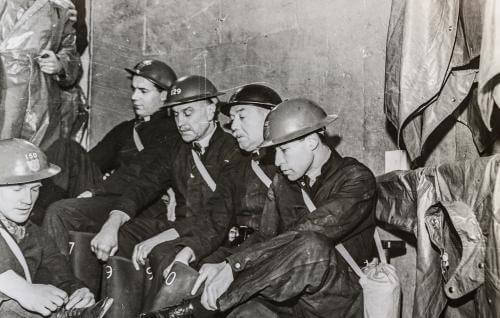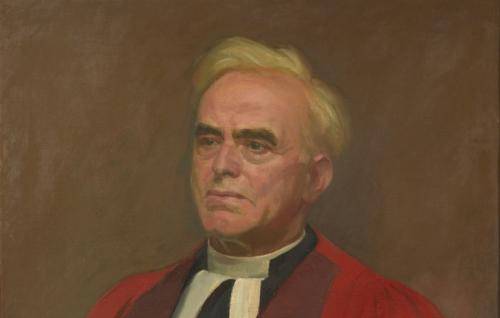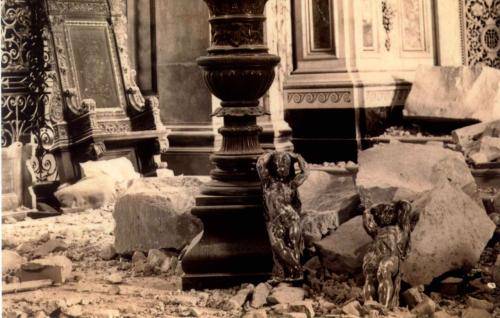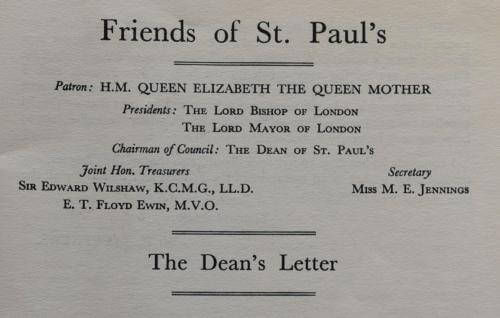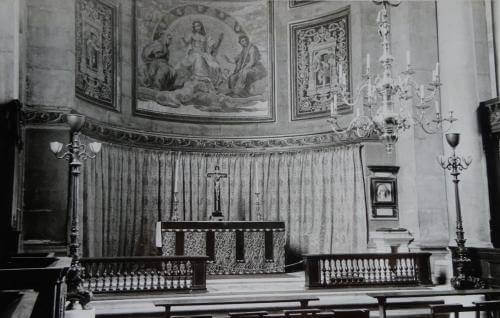Wartime damage and repair

The High Altar at the East End of the Cathedral damaged by a high explosive, 10th October 1940 (Ref. No. 1915).
Wartime damage and repair
It is a common myth that St Paul’s escaped damage during the Blitz, but in fact the Cathedral suffered two direct hits.
The first bomb exploded at the East End on the 10th October 1940, and another over the North Transept on the 16th April 1941.The blast from the East End bomb in 1940 lifted the Quire roof from end to end, causing masonry to fall, which destroyed the altar table below. According to Godfrey Allen, Surveyor to the Fabric, the timber structure of the roof resembled a battleship after an engagement, while the lead covering ‘billowed like waves of the sea’.

Damage to the Cathedral Floor caused by the high explosive, which struck the North Transept on 16 April 1941 (Ref. No. 1916)
'St Paul's rocked'
The damage caused by the North Transept bomb in 1941 was even more significant. After crashing through the roof, it detonated in mid-air, rocking the Dome, pushing the south wall of the South Transept outwards and smashing every window.
The masonry falling through the vault created a hole in the Cathedral floor through which the Crypt could be seen below. Of the North Transept explosion, Watch member A.S.G. Butler recalled:
‘Well, we copped it last night …I’ve got worms in my head with all the noise, and my legs won’t quite walk...Up in the dome area, we felt the shock of it nicely. St Paul’s rocked. But only for an instant; then, quivering, settled down in its habitual majesty.’

Letter to Dean Walter Matthews, from members of the St Paul's Watch, 11 October 1942, to mark their contribution towards the replacement of the keystone to the arch over the High Altar (Ref. No. SPCAA/SPW/3/6/3)
Contributions to repair by the Watch
When repairs were finally started, it was a slow and gradual process. Members of the Watch were responsible for the first significant repair, that of the damaged arch at the East End. They raised £50 for the new keystone, which was installed in October 1942.
They gathered on the altar steps to formally hand over their cheque to the Dean, and look over the new keystone:
‘This is the stone that has stirred the imagination of some past and present members of the Watch – Architects, Builders, Surveyors and others deeply interested in the Cathedral, who all have a very special and intimate knowledge of the Cathedral’s structure, and a profound veneration of the genius of Wren’.

Construction workers and visitors on a construction site near St Paul's, c. 1950s (Ref. No. 1926)
Slow restoration process
It was not until the spring of 1946 that any further repairs were made to the Cathedral. Relying on a public fundraising appeal and support from the War Damage Commission, the vaulting at the East End was repaired, carvings and mosaics were restored, and the new work was re-gilded and decorated.
This extensive work was completed in 1948 in time for King George VI and Queen Elizabeth’s Silver Wedding Anniversary Service.
The repair of the North Transept occurred a few years later and took much longer, being finally re-dedicated in 1962. It was during this period of immense productivity that the Friends were founded.





